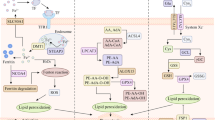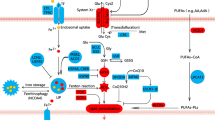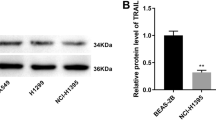Abstract
Ferroptosis refers to a novel way of cell death, inconsistent with the conventional concept of apoptosis and necrosis. It shows a close association with iron metabolism and oxidative damage, as marked by the significant increase of reactive oxygen species, the decreases of mitochondrial volume, and the thickening of membrane density. Recent studies confirmed that ferroptosis is closely associated with the occurrence, development, and therapy of the tumors. As impacted by the high levels of reactive oxygen species and lipid peroxides in lung cancer tissues, it is suggested that ferroptosis is more likely to occur in lung cancer tissues, which may act as a novel approach for non-small cell lung cancer (NSCLC) therapy. In the present study, the research achievements in recent years on the regulating mechanism of ferroptosis and its effect on the occurrence and the therapy of lung cancer are reviewed.


Similar content being viewed by others
Abbreviations
- NSCLC :
-
non-small cell lung cancer
- ROS :
-
reactive oxygen species
- L-OOH :
-
lipid hydroperoxides
- ACSL4 :
-
acyl-CoA synthetase long-chain family member 4
- PUFAs :
-
polyunsaturated fatty acids
- FSP1 :
-
ferroptosis suppressing protein 1
- AIFM2 :
-
apoptosis inducing factor mitochondria 2
- GSH :
-
glutathione
- GPX 4 :
-
glutathione peroxidase 4
- SOCS1 :
-
suppressor of cytokine signaling 1
- EGFR :
-
epidermal growth factor receptor
- TF :
-
transferrin
- TFR1 :
-
transferrin receptor 1
- FTH :
-
ferritin heavy chain
- STEAP3 :
-
six-transmembrane epithelial antigen of prostate 3
- FTL :
-
ferritin light chain
- DMT1 :
-
divalent metal transporter 1
- HSPB1 :
-
heat shock protein B1
- IREB2 :
-
iron response element-binding protein 2
- NCOA4 :
-
nuclear receptor coactivator 4 protein
- HO-1 :
-
heme oxygenase-1
- ISCU :
-
iron–sulfur cluster assembly enzyme
- DHAN :
-
dihydroartemisinin
- LPCAT3 :
-
lysophosphatidylcholine acyltransferase 3
- PEBP1 :
-
phosphatidylethanolamine binding protein 1
- SFA :
-
saturated fatty acid
- VDACs :
-
voltage-dependent anion channel
- lncRNAs :
-
long non-coding RNA
- G3BP1 :
-
Ras-GTPase activated protein binding to protein 1
- STAT3 :
-
signal transducer and activator of transcription 3
- NFS-1 :
-
cysteine desulfurase
- SCLC :
-
small cell lung cancer
- IO NPs :
-
iron oxide nanoparticles
- CTLA4 :
-
cytotoxic T-lymphocyte-associated protein 4
- IKE :
-
imidazole ketone erastin
- DLBCL :
-
diffuse large B cell lymphoma
- TKI :
-
tyrosine kinase inhibitor
- IR :
-
ionizing radiation
References
Alvarez SW, Sviderskiy VO, Terzi EM et al (2017) NFS1 undergoes positive selection in lung tumours and protects cells from ferroptosis. Nature 551(7682):639–643
Anderson GJ (2017) Frazer DM Current understanding of iron homeostasis. Am J Clin Nutr 106(Suppl 6):1559S–1566S
Bersuker K, Hendricks JM, Li Z et al (2019) The CoQ oxidoreductase FSP1 acts parallel to GPX4 to inhibit ferroptosis. Nature 575(7784):688–692
Chang L-C, Chiang S-K, Chen S-E et al (2018) Heme oxygenase-1 mediates BAY 11-7085 induced ferroptosis. Cancer Lett 416124-137
Chen L, Li X, Liu L et al (2015) Erastin sensitizes glioblastoma cells to temozolomide by restraining xCT and cystathionine-γ-lyase function. Oncol Rep 33(3):1465–1474
Chen P, Wu Q, Feng J et al (2020) Erianin, a novel dibenzyl compound in Dendrobium extract, inhibits lung cancer cell growth and migration via calcium/calmodulin-dependent ferroptosis. Signal Transduct Target Ther 5(1):51
Cox AD, Fesik SW, Kimmelman AC et al (2014) Drugging the undruggable RAS: mission possible? Nat Rev Drug Discov 13(11):828–851
Cui W, Liu D, Gu W et al (2021) Peroxisome-driven ether-linked phospholipids biosynthesis is essential for ferroptosis. Cell Death Differ 28(8):2536–2551
Dixon SJ, Lemberg KM, Lamprecht MR et al (2012) Ferroptosis: an iron-dependent form of nonapoptotic cell death. Cell. 149(5):1060–1072
Dixon SJ, Patel DN, Welsch M et al (2014) Pharmacological inhibition of cystine-glutamate exchange induces endoplasmic reticulum stress and ferroptosis. Elife 3e02523
Dixon SJ, Winter GE, Musavi LS et al (2015) Human haploid cell genetics reveals roles for lipid metabolism genes in nonapoptotic cell death. ACS Chem Biol 10(7):1604–1609
Doll S, Proneth B, Tyurina YY et al (2017) ACSL4 dictates ferroptosis sensitivity by shaping cellular lipid composition. Nat Chem Biol 13(1):91–98
Doll S, Freitas FP, Shah R et al (2019) FSP1 is a glutathione-independent ferroptosis suppressor. Nature 575(7784):693–698
Dolma S, Lessnick SL, Hahn WC et al (2003) Identification of genotype-selective antitumor agents using synthetic lethal chemical screening in engineered human tumor cells. Cancer Cell 3(3):285–296
Du J, Wang T, Li Y et al (2019) DHA inhibits proliferation and induces ferroptosis of leukemia cells through autophagy dependent degradation of ferritin. Free Radic Biol Med 131356-369
Eaton JK, Furst L, Ruberto RA et al (2020) Selective covalent targeting of GPX4 using masked nitrile-oxide electrophiles. Nat Chem Biol 16(5):497–506
Feng J, Jiang W, Liu Y et al (2020) Blocking STAT3 by pyrvinium pamoate causes metabolic lethality in KRAS-mutant lung cancer. Biochem Pharmacol 177113960
Friedmann Angeli JP, Schneider M, Proneth B et al (2014) Inactivation of the ferroptosis regulator Gpx4 triggers acute renal failure in mice. Nat Cell Biol 16(12):1180–1191
Gammella E, Recalcati S, Rybinska I et al (2015) Iron-induced damage in cardiomyopathy: oxidative-dependent and independent mechanisms. Oxidative Med Cell Longev 2015230182
Gao M, Monian P (2015) Jiang X Metabolism and iron signaling in ferroptotic cell death. Oncotarget 6(34):35145–35146
Gao M, Monian P, Quadri N et al (2015) Glutaminolysis and transferrin regulate ferroptosis. Mol Cell 59(2):298–308
Gaschler MM, Andia AA, Liu H et al (2018) FINO initiates ferroptosis through GPX4 inactivation and iron oxidation. Nat Chem Biol 14(5):507–515
Guo J, Xu B, Han Q et al (2018) Ferroptosis: a novel anti-tumor action for cisplatin. Cancer Res Treat 50(2):445–460
Hangauer MJ, Viswanathan VS, Ryan MJ et al (2017) Drug-tolerant persister cancer cells are vulnerable to GPX4 inhibition. Nature 551(7679):247–250
Hassannia B, Wiernicki B, Ingold I et al (2018) Nano-targeted induction of dual ferroptotic mechanisms eradicates high-risk neuroblastoma. J Clin Invest 128(8):3341–3355
Hou W, Xie Y, Song X et al (2016) Autophagy promotes ferroptosis by degradation of ferritin. Autophagy 12(8):1425–1428
Ji X, Qian J, Rahman SMJ et al (2018) xCT (SLC7A11)-mediated metabolic reprogramming promotes non-small cell lung cancer progression. Oncogene. 37(36):5007–5019
Jiang L, Kon N, Li T et al (2015) Ferroptosis as a p53-mediated activity during tumour suppression. Nature. 520(7545):57–62
Jiang M, Qiao M, Zhao C et al (2020) Targeting ferroptosis for cancer therapy: exploring novel strategies from its mechanisms and role in cancers. Transl Lung Cancer Res 9(4):1569–1584
Kagan VE, Mao G, Qu F et al (2017) Oxidized arachidonic and adrenic PEs navigate cells to ferroptosis. Nat Chem Biol 13(1):81–90
Kang R (2017) Tang D Autophagy and ferroptosis - what’s the connection? Curr Pathobiol Rep 5(2):153–159
Kazan HH, Urfali-Mamatoglu C (2017) Gunduz U Iron metabolism and drug resistance in cancer. Biometals. 30(5):629–641
Kuang Y (2019) Wang Q Iron and lung cancer. Cancer Lett 46456-61
Lachaier E, Louandre C, Godin C et al (2014) Sorafenib induces ferroptosis in human cancer cell lines originating from different solid tumors. Anticancer Res 34(11):6417–6422
Lee H, Jeong AJ (2019) Ye S-K Highlighted STAT3 as a potential drug target for cancer therapy. BMB Rep 52(7):415–423
Lei G, Zhang Y, Koppula P et al (2020) The role of ferroptosis in ionizing radiation-induced cell death and tumor suppression. Cell Res 30(2):146–162
Li J, Cao F, Yin H-L et al (2020) Ferroptosis: past, present and future. Cell Death Dis 11(2):88
Lin C-H, Lin P-P, Lin C-Y et al (2016) Decreased mRNA expression for the two subunits of system xc(-), SLC3A2 and SLC7A11, in WBC in patients with schizophrenia: evidence in support of the hypo-glutamatergic hypothesis of schizophrenia. J Psychiatr Res 7258-63
Liu T, Liu W, Zhang M et al (2018) Ferrous-supply-regeneration nanoengineering for cancer-cell-specific ferroptosis in combination with imaging-guided photodynamic therapy. ACS Nano 12(12):12181–12192
Lou J-S, Zhao L-P, Huang Z-H et al (2021) Ginkgetin derived from Ginkgo biloba leaves enhances the therapeutic effect of cisplatin via ferroptosis-mediated disruption of the Nrf2/HO-1 axis in EGFR wild-type non-small-cell lung cancer. Phytomedicine 80153370
Louandre C, Ezzoukhry Z, Godin C et al (2013) Iron-dependent cell death of hepatocellular carcinoma cells exposed to sorafenib. Int J Cancer 133(7):1732–1742
Louandre C, Marcq I, Bouhlal H et al (2015) The retinoblastoma (Rb) protein regulates ferroptosis induced by sorafenib in human hepatocellular carcinoma cells. Cancer Lett 356(2 Pt B):971–977
Manz DH, Blanchette NL, Paul BT et al (2016) Iron and cancer: recent insights. Ann N Y Acad Sci 1368(1):149–161
Mao C, Wang X, Liu Y et al (2018) A G3BP1-interacting lncRNA promotes ferroptosis and apoptosis in cancer via nuclear sequestration of p53. Cancer Res 78(13):3484–3496
McBean GJ The transsulfuration pathway: a source of cysteine for glutathione in astrocytes. Amino Acids42(1),199-205 (2012).
Mohrherr J, Uras IZ, Moll HP et al (2020) STAT3: versatile functions in non-small cell lung cancer. Cancers (Basel) 12(5)
Nyiramana MM, Cho SB, Kim E-J et al (2020) Sea hare hydrolysate-induced reduction of human non-small cell lung cancer cell growth through regulation of macrophage polarization and non-apoptotic regulated cell death pathways. Cancers (Basel) 12(3)
Orcutt KP, Parsons AD, Sibenaller ZA et al (2011) Erlotinib-mediated inhibition of EGFR signaling induces metabolic oxidative stress through NOX4. Cancer Res 71(11):3932–3940
Pa M, Xiao H, Yu C et al (2017) Enhanced cisplatin chemotherapy by iron oxide nanocarrier-mediated generation of highly toxic reactive oxygen species. Nano Lett 17(2):928–937
Poursaitidis I, Wang X, Crighton T et al (2017) Oncogene-selective sensitivity to synchronous cell death following modulation of the amino acid nutrient cystine. Cell Rep 18(11):2547–2556
Roh J-L, Kim EH, Jang H et al (2017) Nrf2 inhibition reverses the resistance of cisplatin-resistant head and neck cancer cells to artesunate-induced ferroptosis. Redox Biol 11254-262
Román M, Baraibar I, López I et al (2018) KRAS oncogene in non-small cell lung cancer: clinical perspectives on the treatment of an old target. Mol Cancer 17(1):33
Saint-Germain E, Mignacca L, Vernier M et al (2017) SOCS1 regulates senescence and ferroptosis by modulating the expression of p53 target genes. Aging (Albany NY) 9(10):2137–2162
Schoenfeld JD, Sibenaller ZA, Mapuskar KA et al (2017) O and HO-mediated disruption of Fe metabolism causes the differential susceptibility of NSCLC and GBM cancer cells to pharmacological ascorbate. Cancer Cell 31(4)
Shen Z, Song J, Yung BC et al (2018) Emerging strategies of cancer therapy based on ferroptosis. Adv Mater 30(12):e1704007
Shimada K, Hayano M, Pagano NC et al (2016a) Cell-Line selectivity improves the predictive power of pharmacogenomic analyses and helps identify NADPH as biomarker for ferroptosis sensitivity. Cell Chem Biol 23(2):225–235
Shimada K, Skouta R, Kaplan A et al (2016b) Global survey of cell death mechanisms reveals metabolic regulation of ferroptosis. Nat Chem Biol 12(7):497–503
Sun X, Ou Z, Chen R et al (2016) Activation of the p62-Keap1-NRF2 pathway protects against ferroptosis in hepatocellular carcinoma cells. Hepatology 63(1):173–184
Vanden Berghe T, Linkermann A, Jouan-Lanhouet S et al (2014) Regulated necrosis: the expanding network of non-apoptotic cell death pathways. Nat Rev Mol Cell Biol 15(2):135–147
Viswanathan VS, Ryan MJ, Dhruv HD et al (2017) Dependency of a therapy-resistant state of cancer cells on a lipid peroxidase pathway. Nature 547(7664):453–457
Wang B, Zhang J, Song F et al (2016) EGFR regulates iron homeostasis to promote cancer growth through redistribution of transferrin receptor 1. Cancer Lett 381(2):331–340
Wang M, Mao C, Ouyang L et al (2019a) Long noncoding RNA LINC00336 inhibits ferroptosis in lung cancer by functioning as a competing endogenous RNA. Cell Death Differ 26(11):2329–2343
Wang W, Green M, Choi JE et al (2019b) CD8 T cells regulate tumour ferroptosis during cancer immunotherapy. Nature 569(7755):270–274
Wenzel SE, Tyurina YY, Zhao J et al (2017) PEBP1 wardens ferroptosis by enabling lipoxygenase generation of lipid death signals. Cell 171(3)
Werner ER, Keller MA, Sailer S et al (2020) The gene encodes plasmanylethanolamine desaturase which introduces the characteristic vinyl ether double bond into plasmalogens. Proc Natl Acad Sci U S A 117(14):7792–7798
Yagoda N, von Rechenberg M, Zaganjor E et al (2007) RAS-RAF-MEK-dependent oxidative cell death involving voltage-dependent anion channels. Nature. 447(7146):864–868
Yang WS, SriRamaratnam R, Welsch ME et al (2014) Regulation of ferroptotic cancer cell death by GPX4. Cell 156(1-2):317–331
Yang WS, Kim KJ, Gaschler MM et al (2016) Peroxidation of polyunsaturated fatty acids by lipoxygenases drives ferroptosis. Proc Natl Acad Sci U S A 113(34):E4966–E4975
Yang W-H, Ding C-KC, Sun T et al (2019) The hippo pathway effector TAZ regulates ferroptosis in renal cell carcinoma. Cell Rep 28(10)
Yu H, Han Z, Xu Z et al (2019) RNA sequencing uncovers the key long non-coding RNAs and potential molecular mechanism contributing to XAV939-mediated inhibition of non-small cell lung cancer. Oncol Lett 17(6):4994–5004
Yuan H, Li X, Zhang X et al (2016) Identification of ACSL4 as a biomarker and contributor of ferroptosis. Biochem Biophys Res Commun 478(3):1338–1343
Zhang Y, Tan H, Daniels JD et al (2019a) Imidazole ketone erastin induces ferroptosis and slows tumor growth in a mouse lymphoma model. Cell. Chem Biol 26(5)
Zhang D, Cui P, Dai Z et al (2019b) Tumor microenvironment responsive FePt/MoS nanocomposites with chemotherapy and photothermal therapy for enhancing cancer immunotherapy. Nanoscale 11(42):19912–19922
Zheng D-W, Lei Q, Zhu J-Y et al (2017) Switching apoptosis to ferroptosis: metal-organic network for high-efficiency anticancer therapy. Nano Lett 17(1):284–291
Zhou Z, Song J, Tian R et al (2017) Activatable singlet oxygen generation from lipid hydroperoxide nanoparticles for cancer therapy. Angew Chem Int Ed Eng 56(23):6492–6496
Zou Y, Henry WS, Ricq EL et al (2020) Plasticity of ether lipids promotes ferroptosis susceptibility and evasion. Nature 585(7826):603–608
Availability of data and materials
Not applicable.
Author information
Authors and Affiliations
Contributions
LM Z and YF Z conceived and designed the research. YF Z, RX G, and J L found some paper, YF Z wrote the paper, and LM Z revised the manuscript. All authors approved of the manuscript. The authors declare that all data were generated in-house and that no paper mill was used.
Corresponding author
Ethics declarations
Ethics approval
Not applicable.
Consent to participate
Not applicable.
Consent for publication
Not applicable.
Competing interests
The authors declare no competing interests.
Additional information
Publisher’s note
Springer Nature remains neutral with regard to jurisdictional claims in published maps and institutional affiliations.
Rights and permissions
About this article
Cite this article
Zhang, Y., Guo, R., Li, J. et al. Research progress on the occurrence and therapeutic mechanism of ferroptosis in NSCLC. Naunyn-Schmiedeberg's Arch Pharmacol 395, 1–12 (2022). https://doi.org/10.1007/s00210-021-02178-z
Received:
Accepted:
Published:
Issue Date:
DOI: https://doi.org/10.1007/s00210-021-02178-z




